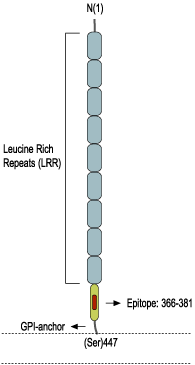Overview
- Peptide (C)GDSPPGNGSGPRHIND corresponding to amino acid residues 366-381 of the human Nogo Receptor (Accession Q9BZR6). Extracellular.

 Cell surface detection of Nogo Receptor in live intact mouse BV-2 microglia cells:___ Cells.
Cell surface detection of Nogo Receptor in live intact mouse BV-2 microglia cells:___ Cells.
___ Cells + rabbit IgG isotype control-FITC.
___ Cells + Anti-Nogo Receptor (extracellular)-FITC Antibody (#ANT-008-F), (2.5 µg). Cell surface detection of Nogo Receptor in live intact human THP-1 monocytic leukemia cells:___ Cells.
Cell surface detection of Nogo Receptor in live intact human THP-1 monocytic leukemia cells:___ Cells.
___ Cells + rabbit IgG isotype control-FITC.
___ Cells + Anti-Nogo Receptor (extracellular)-FITC Antibody (#ANT-008-F), (2.5 µg).
- Kim, M.J. et al. (2018) Cells 8, 1.
- Fournier, A.E. et al. (2001) Nature 409, 341.
- Lee, H. et al. (20018) J. Neurosci. 28, 2753.
- Teng, F.Y.H. and Tang, B.L. (2005) Neurosci. Res. 79, 273.
Neurite outgrowth inhibitor receptor 1 (NgR1, Nogo Receptor) is a glycosylphosphatidylinositol (GPI) transmembrane protein expressed on the surface of axons in the CNS. Its key binding domain is an extracellular leucine-rich repeat domain that interacts with Myelin-associated inhibitory factors (MAIFs) composed of MAG, Neurite outgrowth inhibitor (Nogo)-A, and OMgp1,2.
NgR1 binds to Neurite outgrowth inhibitor (Nogo) through a short hydrophilic loop between two hydrophobic domains. This binding activates intracellular molecular switches through the heteromerization with NgR1 co-receptors, p75NTR and LINGO-1.
This process facilitates neurite outgrowth dynamics; it also governs the plasticity of the CNS at the axo-dendritic and axo-glial levels3.
During CNS neurodegenerative disorders and in animal models of inflammatory demyelination, MAIFs, containing Nogo, accumulate and therefore there is an increased binding to their cognate receptor. This marks Nogo-NgR1 interaction as a potential target of new therapeutics for neurodegenerative diseases4.
Application key:
Species reactivity key:
Anti-Nogo Receptor (extracellular) Antibody (#ANT-008) is a highly specific antibody directed against an epitope of the human protein. The antibody can be used in can be used in western blot, immunohistochemistry and live cell imaging applications. It has been designed to recognize NgR1 from human, mouse and rat samples.
Anti-Nogo Receptor (extracellular)-FITC Antibody (#ANT-008-F) is directly conjugated to fluorescein isothiocyanate (FITC). The antibody can be used in immunofluorescent applications such as direct live cell flow cytometry.
